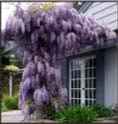Climbers
Climbers create rooms and atmosphere in the garden
Selection
Consider how high and how fast you want your climber to grow, how it climbs, and the best method of support.
Make your selection according to the method of climbing.
Clinging plants send out little aerial roots with suckers on the end. They climb brick, concrete, stone, or timber—e.g. Boston Ivy and Virginia Creeper.
Aerial roots grow from some plants, finding their way into cracks and crevices of walls and rockeries—e.g. English Ivy.
The majority of climbers twine their stems around supports. A pergola, trellis or netting is ideal—e.g. Trachelospermum and Jasmine.
Tendril climbers have thread-like tendrils that twist around supports. A narrow trellis or wire mesh is ideal. Clematis species, Jasmine, and Grape vines are tendril climbers.
There is another group of climbers with long arching stems that respond to training, tying, and support. They are often rambling in habits like roses and bougainvilleas.
Whatever the method, training must start when the plant is young.


When to Plant
Autumn, winter, and early spring are the best times to plant, depending on when the plant is available of course.
Where to Plant
The majority of climbers require well-drained average garden soil with plenty of compost and organic material dug in before planting.
When to Plant
Autumn, winter, and early spring are the best times to plant, depending on when the plant is available of course.
How to Plant
Climbers are usually planted as permanent features in the garden because they require some form of support.
Refer to our brochure on How to Plant for more information.
AFTER CARE
Twining, suckering, or plants with aerial roots or tendrils need to be trained to shape as they grow.
Ramblers and woody stem plants need to be tied progressively.
Pruning
Prune annually. It is essential to maintain vigorous growth, an abundance of flowers, and plenty of branching.
Foliage climbers are best pruned in late winter.
Flowering climbers fall into two categories.
- Those that flower on new growth need pruning in late winter or early spring—e.g. Honeysuckle and trumpet Vine (Campsis) and wisteria.
- Those that flower on woody growth need pruning after flowering—e.g. Jasmine & Pandorea.
Some do not need pruning at all, except to remove old dead wood—e.g. Clematis and the native Clematis varieties.
Feeding
Apply a complete plant food such as Tui General Garden fertiliser in late winter/early spring, then again in mid-summer. Water in well.
Mulching
Mulch in late winter and again in mid-summer to keep the soil moist and the roots cool.

Watering
Water regularly from spring through summer.
Deep watering is more effective than light sprinklings. This encourages the roots to penetrate the soil deeply.
Pests and Diseases
Climbers are relatively pest and disease-free if given ideal growing conditions.
Aphids are small sucking insects that appear on new growth. Hose off, squash with fingers, or spray with Yates Pyrethrum or Bug Oil.
Thrips are small black-sucking insects that cause the leaves to go silverily speckled in colour. Spray with Mavrik or Yates Success Ultra.
Leaf Roller Caterpillars chew holes in leaves and flowers and roll themselves up in the leaves with webbing. Squash the caterpillar with fingers, but it’s more effective to control with Yates Success Ultra.
6191